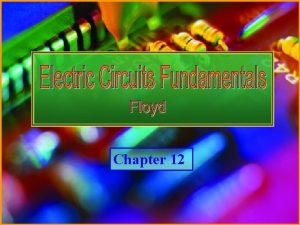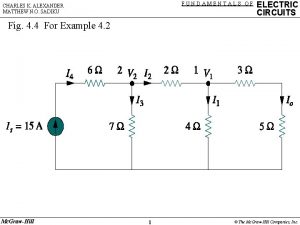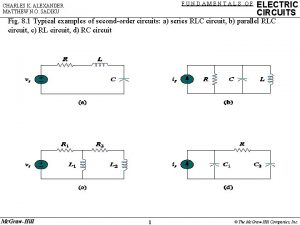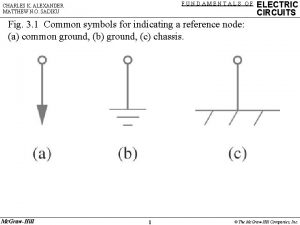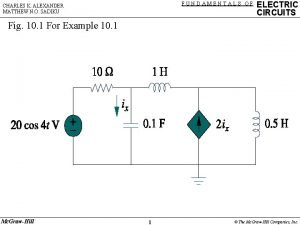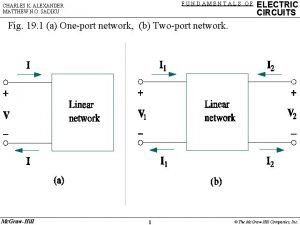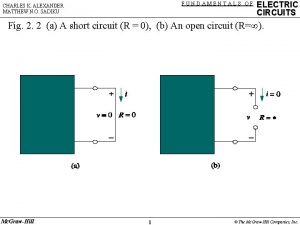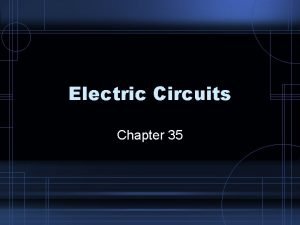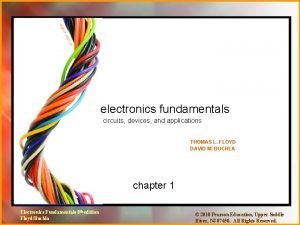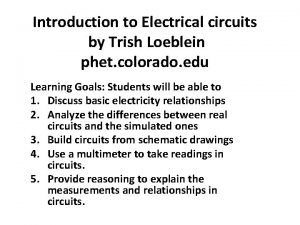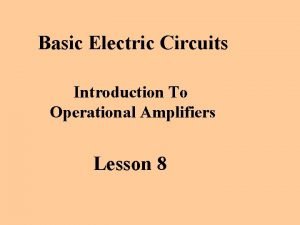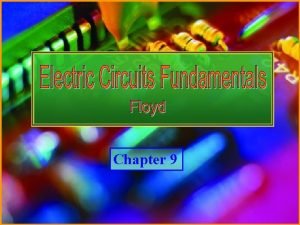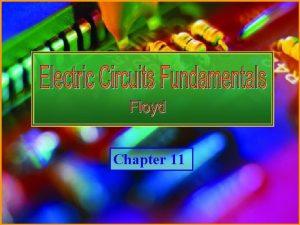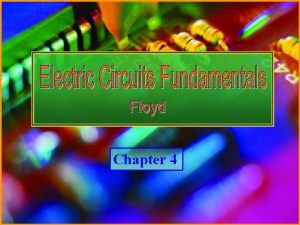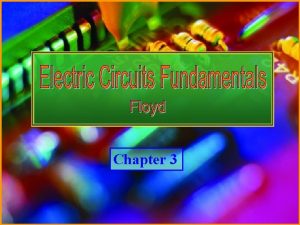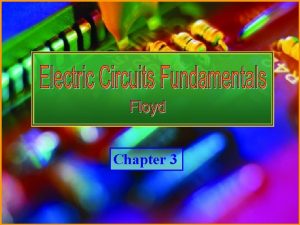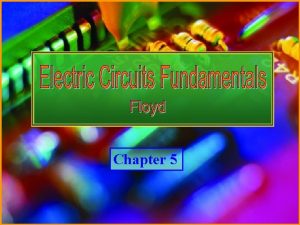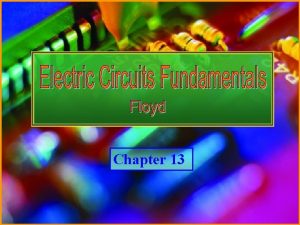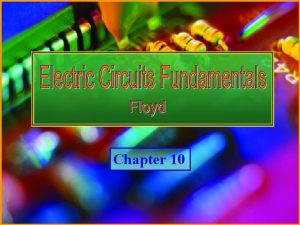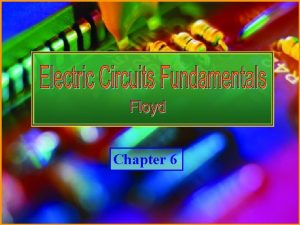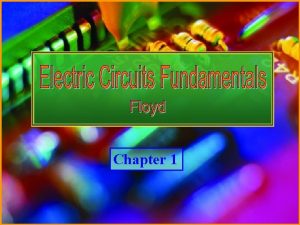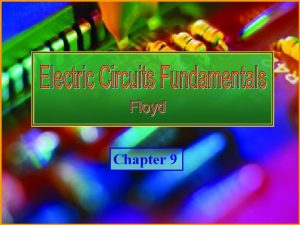Chapter 8 Electric Circuits Fundamentals Floyd Copyright 2007





























- Slides: 29

Chapter 8 Electric Circuits Fundamentals - Floyd © Copyright 2007 Prentice-Hall

Chapter 8 Summary Sine waves The sinusoidal waveform (sine wave) is the fundamental alternating current (ac) and alternating voltage waveform. Electrical sine waves are named from the mathematical function with the same shape. Electric Circuits Fundamentals - Floyd © Copyright 2007 Prentice-Hall

Chapter 8 Summary A wave is a disturbance. Unlike water waves, electrical waves cannot be seen directly but they have similar characteristics. All periodic waves can be constructed from sine waves, which is why sine waves are fundamental. Electric Circuits Fundamentals - Floyd © Copyright 2007 Prentice-Hall

Chapter 8 Summary Sine waves are characterized by the amplitude and period. The amplitude is the maximum value of a voltage or current; the period is the time interval for one complete cycle. The amplitude (A) of this sine wave is 20 V A The period is 50. 0 ms T Electric Circuits Fundamentals - Floyd © Copyright 2007 Prentice-Hall

Chapter 8 Summary Sine waves The period of a sine wave can be measured between any two corresponding points on the waveform. TT T T A T T By contrast, the amplitude of a sine wave is only measured from the center to the maximum point. Electric Circuits Fundamentals - Floyd © Copyright 2007 Prentice-Hall

Chapter 8 Summary Frequency ( f ) is the number of cycles that a sine wave completes in one second. Frequency is measured in hertz (Hz). If 3 cycles of a wave occur in one second, the frequency is 3. 0 Hz 1. 0 s Electric Circuits Fundamentals - Floyd © Copyright 2007 Prentice-Hall

Chapter 8 Summary Period and frequency The period and frequency are reciprocals of each other. and Thus, if you know one, you can easily find the other. (The 1/x key on your calculator is handy for converting between f and T. ) If the period is 50 ms, the frequency is 0. 02 MHz = 20 k. Hz. Electric Circuits Fundamentals - Floyd © Copyright 2007 Prentice-Hall

Chapter 8 Sine wave voltage and current values There are several ways to specify the voltage of a sinusoidal voltage waveform. The amplitude of a sine wave is also called the peak value, abbreviated as VP for a voltage waveform. The peak voltage of this waveform is 20 V. Electric Circuits Fundamentals - Floyd VP © Copyright 2007 Prentice-Hall

Chapter 8 Sine wave voltage and current values The voltage of a sine wave can also be specified as either the peak-to-peak or the rms value. The peak-topeak is twice the peak value. The rms value is 0. 707 times the peak value. The peak-to-peak voltage is 40 V. The rms voltage is 14. 1 V. Electric Circuits Fundamentals - Floyd Vrms VPP © Copyright 2007 Prentice-Hall

Chapter 8 Sine wave voltage and current values For some purposes, the average value (actually the halfwave average) is used to specify the voltage or current. By definition, the average value is as 0. 637 times the peak value. The average value for the sinusoidal voltage is 12. 7 V. Electric Circuits Fundamentals - Floyd Vavg © Copyright 2007 Prentice-Hall

Chapter 8 Angular measurements can be made in degrees (o) or radians. The radian (rad) is the angle that is formed when the arc is equal to the radius of a circle. There are 360 o or 2 p radians in one complete revolution. Electric Circuits Fundamentals - Floyd © Copyright 2007 Prentice-Hall

Chapter 8 Angular measurement Because there are 2 p radians in one complete revolution and 360 o in a revolution, the conversion between radians and degrees is easy to write. To find the number of radians, given the number of degrees: To find the number of degrees, given the radians: Electric Circuits Fundamentals - Floyd © Copyright 2007 Prentice-Hall

Chapter 8 Sine wave equation Instantaneous values of a wave are shown as v or i. The equation for the instantaneous voltage (v) of a sine wave is where Vp = Peak voltage q = Angle in rad or degrees If the peak voltage is 25 V, the instantaneous voltage at 50 degrees is 19. 2 V Electric Circuits Fundamentals - Floyd © Copyright 2007 Prentice-Hall

Chapter 8 Sine wave equation A plot of the example in the previous slide (peak at 25 V) is shown. The instantaneous voltage at 50 o is 19. 2 V as previously calculated. Electric Circuits Fundamentals - Floyd © Copyright 2007 Prentice-Hall

Chapter 8 Phasors The sine wave can be represented as the projection of a vector rotating at a constant rate. This rotating vector is called a phasor. Phasors are useful for showing the phase relationships in ac circuits. Electric Circuits Fundamentals - Floyd © Copyright 2007 Prentice-Hall

Chapter 8 Phase shift The phase of a sine wave is an angular measurement that specifies the position of a sine wave relative to a reference. To show that a sine wave is shifted to the left or right of this reference, a term is added to the equation given previously. where f = Phase shift Electric Circuits Fundamentals - Floyd © Copyright 2007 Prentice-Hall

Chapter 8 Phase shift Example of a wave that lags the reference …and the equation has a negative phase shift v = 30 V sin (q - 45 o) Notice that a lagging sine wave is below the axis at 0 o Electric Circuits Fundamentals - Floyd © Copyright 2007 Prentice-Hall

Chapter 8 Phase shift Example of a wave that leads the reference Notice that a leading sine wave is above the axis at 0 o v = 30 V sin (q + 45 o) …and the equation has a positive phase shift Electric Circuits Fundamentals - Floyd © Copyright 2007 Prentice-Hall

Chapter 8 Power in resistive AC circuits The power relationships developed for dc circuits apply to ac circuits except you must use rms values when calculating power. The general power formulas are: Electric Circuits Fundamentals - Floyd © Copyright 2007 Prentice-Hall

Chapter 8 Power in resistive AC circuits Assume a sine wave with a peak value of 40 V is applied to a 100 W resistive load. What power is dissipated? Vrms = 0. 707 x Vp = 0. 707 x 40 V = 28. 3 V 8 W Electric Circuits Fundamentals - Floyd © Copyright 2007 Prentice-Hall

Chapter 8 Superimposed dc and ac voltages Frequently dc and ac voltages are together in a waveform. They can be added algebraically, to produce a composite waveform of an ac voltage “riding” on a dc level. Electric Circuits Fundamentals - Floyd © Copyright 2007 Prentice-Hall

Chapter 8 Pulse definitions Ideal pulses Electric Circuits Fundamentals - Floyd © Copyright 2007 Prentice-Hall

Chapter 8 Pulse definitions Non-ideal pulses Notice that rise and fall times are measured between the 10% and 90% levels whereas pulse width is measured at the 50% level. Electric Circuits Fundamentals - Floyd © Copyright 2007 Prentice-Hall

Chapter 8 Triangular and sawtooth waves Triangular and sawtooth waveforms are formed by voltage or current ramps (linear increase/decrease) Triangular waveforms have positive-going and negativegoing ramps of equal duration. The sawtooth waveform consists of two ramps, one of much longer duration than the other. Electric Circuits Fundamentals - Floyd © Copyright 2007 Prentice-Hall

Chapter 8 Harmonics All repetitive non-sinusoidal waveforms are composed of a fundamental frequency (repetition rate of the waveform) and harmonic frequencies. Odd harmonics are frequencies that are odd multiples of the fundamental frequency. Even harmonics are frequencies that are even multiples of the fundamental frequency. Electric Circuits Fundamentals - Floyd © Copyright 2007 Prentice-Hall

Chapter 8 Harmonics A square wave is composed only of the fundamental frequency and odd harmonics (of the proper amplitude). Electric Circuits Fundamentals - Floyd © Copyright 2007 Prentice-Hall

Chapter 8 Selected Key Terms Sine wave A type of waveform that follows a cyclic sinusoidal pattern defined by the formula y = A sin q. Alternating Current that reverses direction in response to a current change in source voltage polarity. Period (T) The time interval for one complete cycle of a periodic waveform. Frequency (f) A measure of the rate of change of a periodic function; the number of cycles completed in 1 s. Hertz The unit of frequency. One hertz equals one cycle per second. Electric Circuits Fundamentals - Floyd © Copyright 2007 Prentice-Hall

Chapter 8 Selected Key Terms Instantaneous The voltage or current value of a waveform at value a given instant in time. Peak value The voltage or current value of a waveform at its maximum positive or negative points. Peak-to-peak The voltage or current value of a waveform value measured from its minimum to its maximum points. rms value The value of a sinusoidal voltage that indicates its heating effect, also known as effective value. It is equal to 0. 707 times the peak value. rms stands for root mean square. Electric Circuits Fundamentals - Floyd © Copyright 2007 Prentice-Hall

Chapter 8 Selected Key Terms Radian A unit of angular measurement. There are 2 p radians in one complete 360 o revolution. Phase The relative angular displacement of a time-varying waveform in terms of its occurrence with respect to a reference. Amplitude The maximum value of a voltage or current. Pulse A type of waveform that consists of two equal and opposite steps in voltage or current separated by a time interval. Harmonics The frequencies contained in a composite waveform, which are integer multiples of the pulse repetition frequency. Electric Circuits Fundamentals - Floyd © Copyright 2007 Prentice-Hall
 Electric circuits fundamentals floyd
Electric circuits fundamentals floyd Fundamentals of electric circuits chapter 4 solutions
Fundamentals of electric circuits chapter 4 solutions The circuit chapter 9
The circuit chapter 9 Fundamentals of electric circuits chapter 7 solutions
Fundamentals of electric circuits chapter 7 solutions Fundamentals of electric circuits
Fundamentals of electric circuits Fundamentals of electric circuits
Fundamentals of electric circuits Fundamentals of electric
Fundamentals of electric Fundamentals of electric circuits
Fundamentals of electric circuits Alexander
Alexander Fundamentals of electric circuits
Fundamentals of electric circuits Quarturs
Quarturs Digital fundamentals floyd ppt
Digital fundamentals floyd ppt Digital fundamentals by floyd 10th edition
Digital fundamentals by floyd 10th edition Digital fundamentals by floyd 10th edition
Digital fundamentals by floyd 10th edition Electric current
Electric current Chapter 35 electric circuits
Chapter 35 electric circuits Chapter 20 electric circuits
Chapter 20 electric circuits Chapter 35 electric circuits answers
Chapter 35 electric circuits answers Chapter 35 electric circuits answers
Chapter 35 electric circuits answers Chapter 35 electric circuits
Chapter 35 electric circuits Series parallel circuit current
Series parallel circuit current Electronics fundamentals circuits devices and applications
Electronics fundamentals circuits devices and applications Chapter 21 electric charge and electric field
Chapter 21 electric charge and electric field Chapter 21 electric charge and electric field
Chapter 21 electric charge and electric field Coulombs constant units
Coulombs constant units Dc o/d per item charge
Dc o/d per item charge Copyright 2007
Copyright 2007 Pearson
Pearson Phet build a circuit
Phet build a circuit Electric circuits equations
Electric circuits equations
